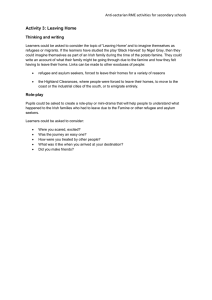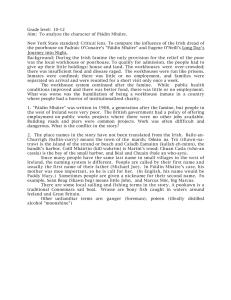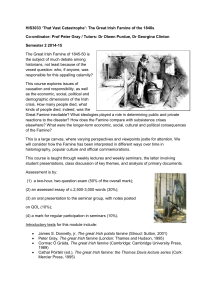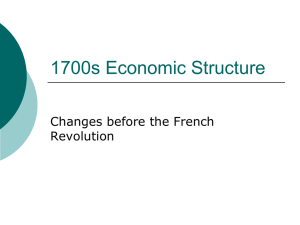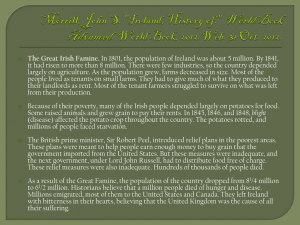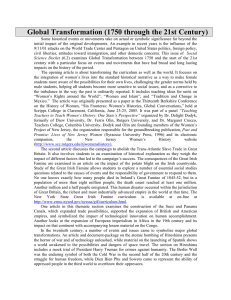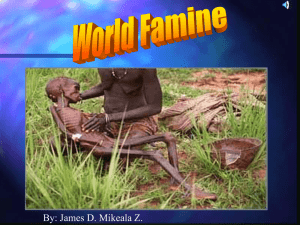INTERDISCIPLINARY MIDDLE GRADES (4-8) PACKAGE AIM 7.11: Is famine avoidable today? ASSESSMENT:
advertisement
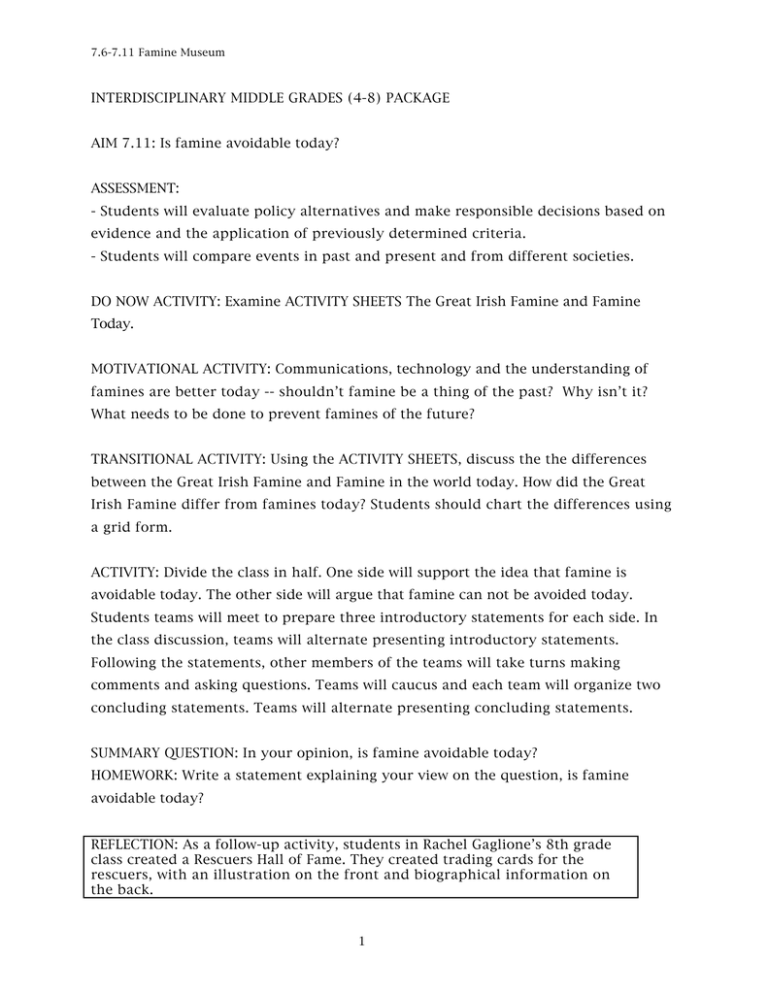
7.6-7.11 Famine Museum INTERDISCIPLINARY MIDDLE GRADES (4-8) PACKAGE AIM 7.11: Is famine avoidable today? ASSESSMENT: - Students will evaluate policy alternatives and make responsible decisions based on evidence and the application of previously determined criteria. - Students will compare events in past and present and from different societies. DO NOW ACTIVITY: Examine ACTIVITY SHEETS The Great Irish Famine and Famine Today. MOTIVATIONAL ACTIVITY: Communications, technology and the understanding of famines are better today -- shouldn’t famine be a thing of the past? Why isn’t it? What needs to be done to prevent famines of the future? TRANSITIONAL ACTIVITY: Using the ACTIVITY SHEETS, discuss the the differences between the Great Irish Famine and Famine in the world today. How did the Great Irish Famine differ from famines today? Students should chart the differences using a grid form. ACTIVITY: Divide the class in half. One side will support the idea that famine is avoidable today. The other side will argue that famine can not be avoided today. Students teams will meet to prepare three introductory statements for each side. In the class discussion, teams will alternate presenting introductory statements. Following the statements, other members of the teams will take turns making comments and asking questions. Teams will caucus and each team will organize two concluding statements. Teams will alternate presenting concluding statements. SUMMARY QUESTION: In your opinion, is famine avoidable today? HOMEWORK: Write a statement explaining your view on the question, is famine avoidable today? REFLECTION: As a follow-up activity, students in Rachel Gaglione’s 8th grade class created a Rescuers Hall of Fame. They created trading cards for the rescuers, with an illustration on the front and biographical information on the back. 1 7.6-7.11 Famine Museum COMPARING FAMINES TODAY WITH THE GREAT IRISH FAMINE Problems Great Irish Famine Economic Development Land Ownership Food Availability Government Response Private Aid Other Issues 2 Famine Today 7.6-7.11 Famine Museum ACTIVITY SHEET A - THE GREAT IRISH FAMINE Aid: Groups such as the Society of Friends and the St. Vincent de Paul Society set up soup kitchens. Indian corn came from the USA but it was too difficult to mill into flour and too hard to digest. Poverty: Ireland was a very poor country. Little foreign capital had been invested in Ireland and so the industrial revolution by-passed the country. Most people depended on agriculture to survive. Land: By 1750, only 5% of the land belonged to the Irish. At the time of the Great Irish Famine, much of the land was owned by absentee landlords. Tenants could easily be evicted. Food: There was enough food to feed the Irish people. The problem was the people could not afford to buy it because agricultural prices had dropped and rents increased. Social Welfare: There was no social welfare. Political Structures: Ireland was under colonial rule. The British government adopted a “Laissez faire” policy and so was slow to respond. Low Life Expectancy: In Ireland of the 1850s it was 38 years. Emigration: Many Irish left for the U.S.A., Australia and Britain. War and Peace: Ireland was relatively peaceful although the famine led to resentment and protests against English rule. Famine Prediction: This was more difficult in the 19th century. The potato blight was incorrectly diagnosed as a kind of “wet rot” which was not expected to reoccur. Trade: Ireland was governed by the trade regulations of Great Britain. 3 7.6-7.11 Famine Museum ACTIVITY SHEET B - FAMINE TODAY Aid: Western governments and organizations send aid. Local groups distribute food. Food often arrives too late and may compete with local farmers’ produce. Poverty: Countries affected by famine are among the poorest in the world. SubSaharan Africa has mostly a rural population which depends on agriculture. The poor at most affected by famine. Land: Most land is controlled by large farmers producing cash crops. Food: Many people are too poor to buy food. During drought nomads in the Sahel lose livestock which they need to sell to buy food while the price of food has risen. Social Welfare: 32 out of 43 countries in Africa have no form of social welfare. Political Structures: African countries have a history of colonial domination. Corrupt governments are supported by Western powers who provide weapons. Low Life Expectancy: In Somalia, it is 47 (compared with 76 in Ireland today). Emigration: Most countries in Africa are too poor to support refugees. War & Peace: Ethiopia, Somalia, Sudan, and Mozambique all had recent wars. Famine Prediction: It is easier to predict famine today. It is projected that by 2010 people in Sub-Saharan will have a daily calorie intake of 2,170 calories, compared with 3,470 in industrialised countries. Debt: Many countries struggle to repay debts. The International Monetary Fund lends the Third World money if subsidies on foods are removed and the best land is used for cash crops. Trade: Prices of exports such as coffee dropped because large companies control the market. If governments cut tariffs, they lose needed income. Small farmers need greater help processing, marketing, and selling products. 4

